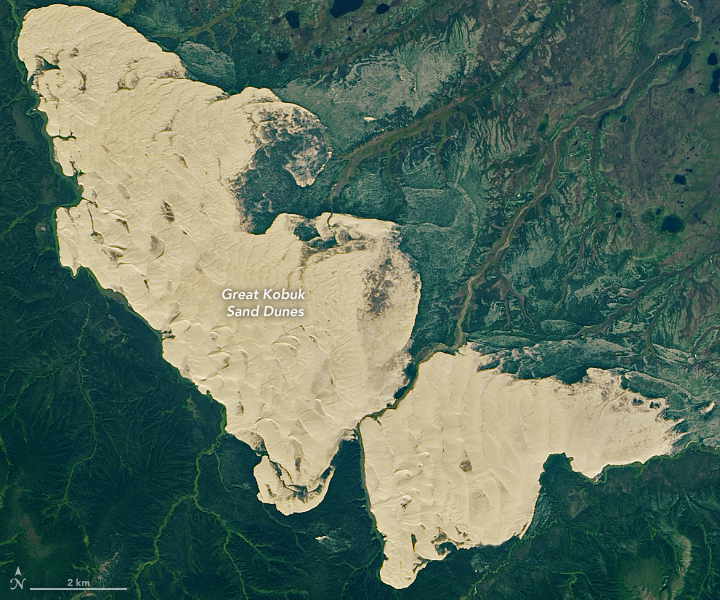

An Unexpected Expanse of Sand in Alaska
Downloads
- kobukdunes_oli_2020229_lrg.jpg (4084x5114, JPEG)
- kobukduneswide_oli_2020229.jpg (720x699, JPEG)
Metadata
- Sensor(s):
- Landsat 8 - OLI
- Data Date: August 16, 2020
- Visualization Date: December 1, 2020
Within an expanse of boreal forest in northwestern Alaska, two treeless stretches of sand stand out—the Great Kobuk Sand Dunes. With crests that rise as high as 100 feet (30 meters) above the surrounding forests, the dunes look like they belong in the Saharan Desert more than in the Arctic.
The dunes owe their existence to glacial ice. During recent ice age cycles, massive sheets of ice bulldozed mountains and other rocky surfaces in the region, creating an abundance of sand, silt, and loess that collected along the banks of glacial streams. Over time, sediment-laden streams and dust-filled winds deposited much of that material in the ice-free Kobuk Valley, which is sheltered by the Baird Mountains to the north and the Waring Mountains to the south.
The Operational Land Imager (OLI) on Landsat 8 acquired this image of the Kobuk Valley and its dunes on August 16, 2020. While tundra grasses and forests have encroached upon and now cover about 90 percent of the sand that blankets Kobuk Valley, shifting winds still freely sculpt roughly 25 square miles (65 square kilometers) of active dunes fields. Ridge-like transverse dunes are common in the northern part of the Great Kobuk Dune Field, while crescent-shaped barchan and parabolic dunes appear in significant numbers in the southern part.
The dunes are one of the highlights of Kobuk Valley National Park—one of the most remote sites in the U.S. national park system. While hundreds of thousands of caribou migrate through the park each year, the absence of roads and other facilities means the number of human visitors to the park is typically less than 20,000, and often much lower.
One notable group has made the journey to Kobuk: geologists who study dunes on Mars. Since the Great Kobuk dunes are frozen and crusted with snow and frost for much of the year, they move quite slowly in comparison to dunes in warmer areas. They are akin to sand dunes on Mars, some of which have ice-like layers of frozen carbon dioxide frost during the winter. In fact, scientists from the Southwest Research Institute first discovered that sand dunes on Mars can move by using a satellite-based technique that they initially developed and tested among the Great Kobuk dunes.
References
- Dinwiddie, C. (2012) Mars on Earth: The Great Kobuk Sand Dunes in Alaska provide an Earth analog for Martian geology. Accessed December 1, 20202.
- Mann, D.H. et al. (2002) Holocene history of the Great Kobuk Sand Dunes, Northwestern Alaska. Quaternary Science Reviews, 21 (4-6), 7089-731.
- NASA Earth Data (2010) Unearthly dunes. Accessed December 1, 20202.
- National Park Service Great Kobuk Sand Dunes. Accessed December 1, 2020.
- National Park Service (2012, August 28) The Great Kobuk Sand Dunes: A Cloudy (and Warming) Crystal Ball for Mars. Accessed December 1, 2020.
- Necsoiu, N. et al. (2009) Monitoring migration rates of an active subarctic dune field using optical imagery. Remote Sensing of Environment, 113 (11), 2441-2447.
- Necsoiu, N. et al. (2009) Recent Migration Rates of the Great Kobuk Sand Dunes, Alaska: Technologic and Scientific Implications for Planetary Dune Systems. Accessed December 1, 2020.
NASA Earth Observatory images by Lauren Dauphin, using Landsat data from the U.S. Geological Survey. Story by Adam Voiland.
This image record originally appeared on the Earth Observatory. Click here to view the full, original record.